Day 2 of a three day long weekend of tours today, and we headed off down to the Broads. We were back to rather grey and cloudy weather today, after the clear skies of yesterday morning, but it was not foggy and it was dry all day.
Our first destination was Ludham. When we climbed out of the car, the first birds we could see were two Mute Swans by the car park. We could see their orange bills with a prominent black knob. We had come here to look for swans, but not these ones.
We walked up onto the bank and a short distance along the path. From here, we could see more swans out on the grazing meadows behind the barns. They looked smaller than the Mute Swans we had just been looking at and through the scope we could see they had square yellow patches on their bills. They were Bewick’s Swans, about 40 of them.
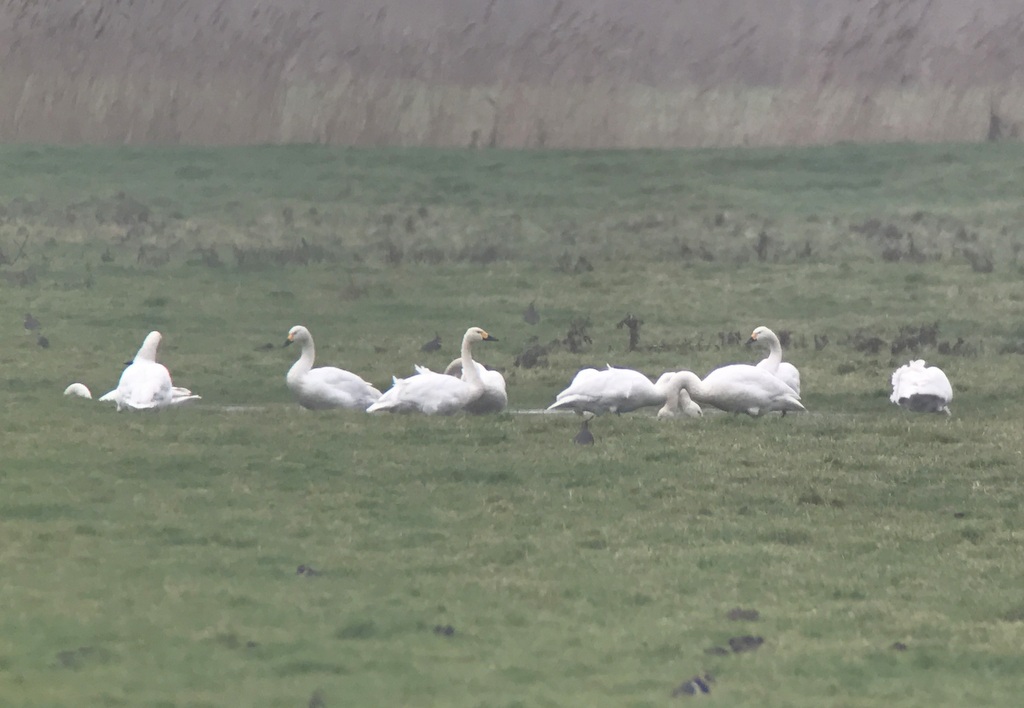
Bewick’s Swan numbers in the Broads are well down this winter, so far. It appears that many of the swans have decided to stay on the continent, given mild conditions and plenty of food still there, so it was nice to see this many today. It we get a cold snap on the continent, more may well yet come here. There are often Whooper Swans with the Bewick’s Swans too, but they are rather mobile and come and go during the day, and there were none here this morning.
There were several Marsh Harriers quartering the marshes behind the swans. A small flock of Wigeon flew over along the river. We heard Bearded Tits calling from the reeds below the bank but they remained tucked well down out of view. We had a quick drive round to St Benet’s but there were no more swans there, so we decided to make our way down to the coast.
Round at Horsey, we found a much larger herd of swans. This used to be the best place to find the Bewick’s Swans but these days they seem to prefer the Ludham area. Sure enough, the vast majority of birds here were Mute Swans, as is usually the case these days. However, a careful scan through the herd did reveal a couple of Bewick’s Swans with them.
A little further on up the coast, we stopped again. A quick scan of the grazing marshes before we even got out of the car revealed two Common Cranes walking about on the grass nearby. We disembarked and were soon enjoying great views of them through the scope.

The Cranes were walking around in a wet grassy field, with lots of rushy tussocks, occasionally bending down to peck at something in the vegetation. We could see their black necks with bold white stripes behind the eye meeting on the back of the neck, and the bustle of ornamental feathers at the rear of their bodies. For birds which stand about a metre or more tall, they can be remarkably unobtrusive.
There were a couple of Egyptian Geese here too and lots of Lapwings out on the shorter grass. A small flock of Golden Plover got up and wheeled round before landing back down out in the middle. A little group of Fieldfares flew in and landed in front of us on the grass.
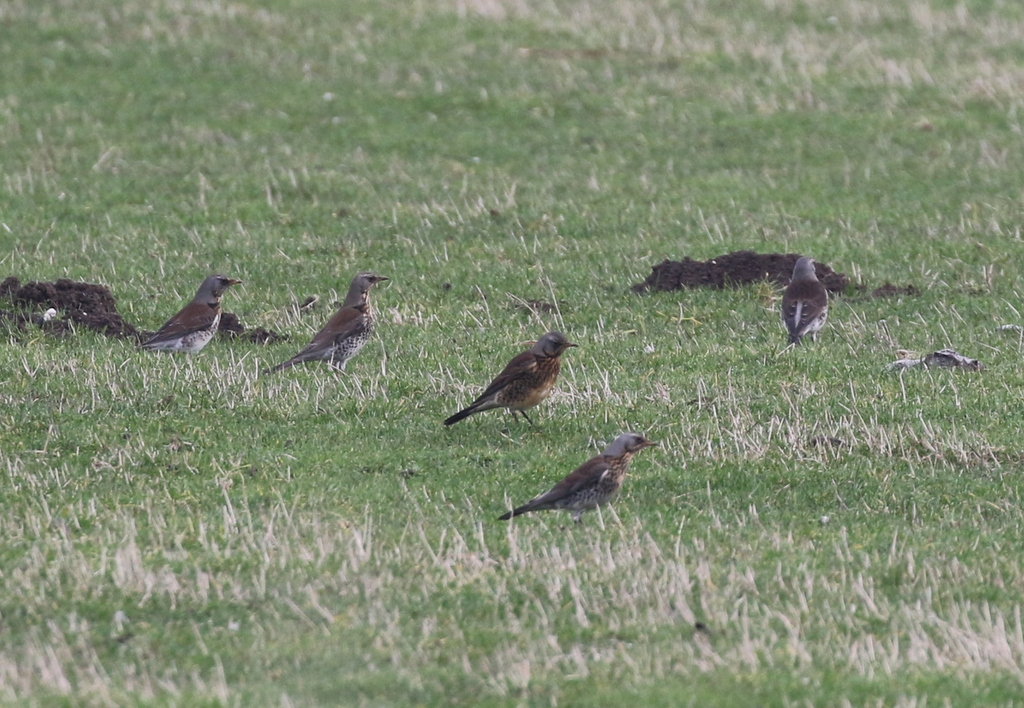
After a quick pitstop, we made our way up to Waxham next. There is a Hume’s Warbler here at the moment – a rare visitor here which breeds in Russia and Central Asia and should normally be found wintering on the Indian subcontinent. It can be very elusive at times, but we thought we would have a quick look for it, as we were in the area.
As we walked in along the sandy track that leads to the beach, a Goldcrest flew down the hedge towards us and landed right beside us. It was flitting around in the ivy oblivious to our presence. There was a large crowd of people gathered by the bushes on the edge of the dunes. We assumed at first they were watching the Hume’s Warbler, but it turned out they had not seen it for over an hour and were simply waiting for it to reappear.
Rather than just stand around where the Hume’s Warbler was obviously not, we decided to walk south along the path below dunes and try our luck along there. We hadn’t gone very far when we saw a couple of people who waved us over – the Hume’s Warbler had just been seen here. It seemed to have disappeared again, but as we stood on the path scanning the bushes, one of the group spotted some movement down on the ground in the Alexanders only a few metres in front of us and out it hopped.
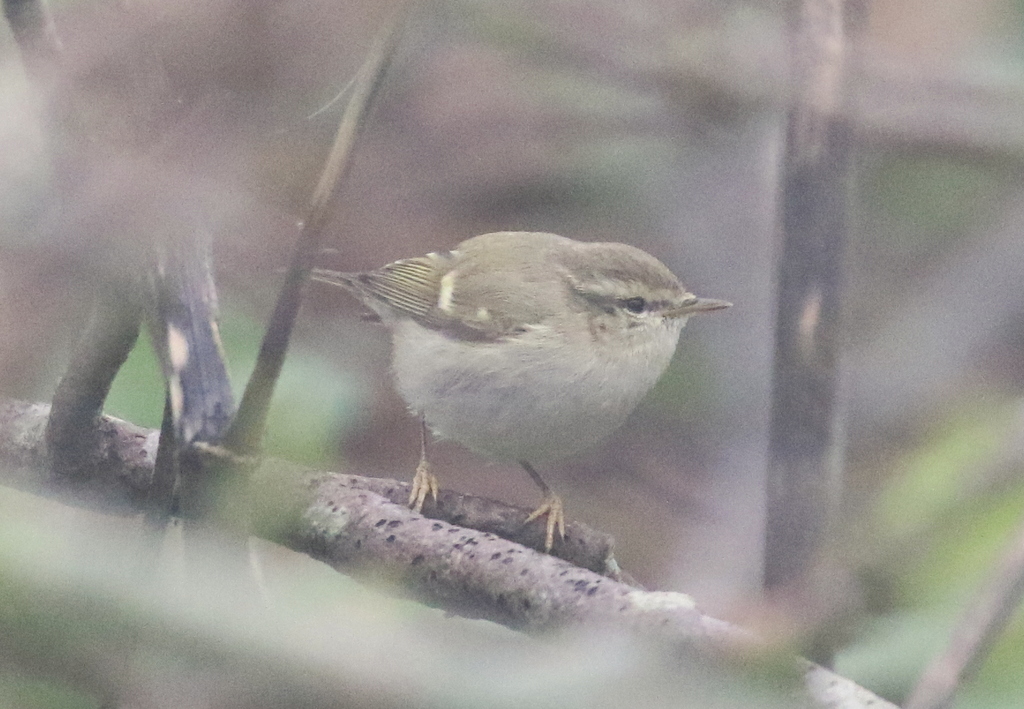
The Hume’s Warbler was constantly on the move and difficult to see well unless you were quick. Eventually, everyone got a look at it and most of the group had good views as it flitted around in the ivy covering a hawthorn by the path. When it disappeared again behind a thick clump of brambles, we started to make our way back to the car.
We had only walked a short distance back up the path, and had just stopped to look at a picture of Hume’s Warbler in the book, when it flew out again, right over our heads and landed in top of the hawthorn right in front of us calling. The call is one of the best ways to tell Hume’s Warbler from the rather similar and more common Yellow-browed Warbler, so this was great to hear. It flew back into some ivy covered trees beyond and we left it to it.
Back in the car, we headed south along the coast road, scanning the fields on the way. We quickly found three more Cranes. These were more distant than the ones we had seen earlier, and we had seen those so well, so we didn’t stop. A big flock of Fieldfares in a rape field next to the road had a few Redwings with them.
A little further along, we noticed a large pale bird flying over the field beside the road – a stunning male Hen Harrier, ghostly grey with black wing tips. It was hunting, moving fast and low over the fields, but managed to follow alongside it in the car, enjoying a great view of it before it turned inland.
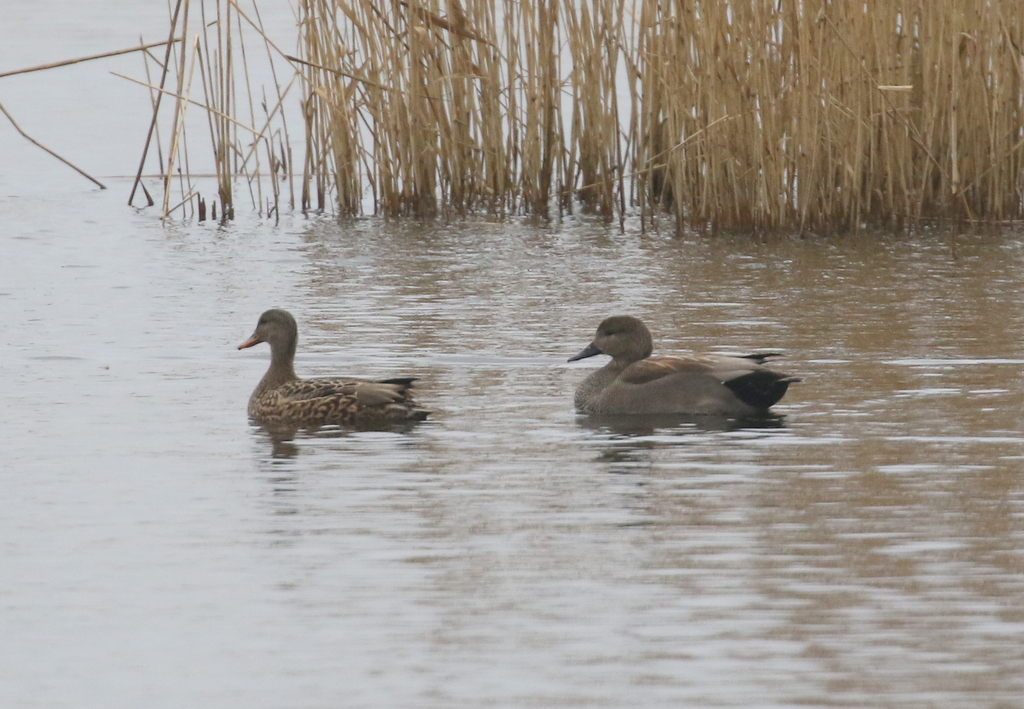
We made our way over to Strumpshaw Fen for lunch. At the pool in front of reception hide, there were lots of ducks out on the water, mainly Mallard & Gadwall. A single young drake Shoveler swam out of the reeds. There were a couple of Mute Swans, and after a while the resident feral Black Swan swam out from behind the reeds.
There was a steady stream of tits coming into the feeders by the picnic tables. They were mainly Blue Tits and Great Tits, but a Coal Tit came down and spent some time attacking the peanuts. Two or three Marsh Tits made a brief visit too. At first we only caught sight of them as they were leaving, when we heard them calling in the trees above our heads. A little later we heard another Marsh Tit approaching through the sallows and this time we watched it darting in and grabbing sunflower hearts.
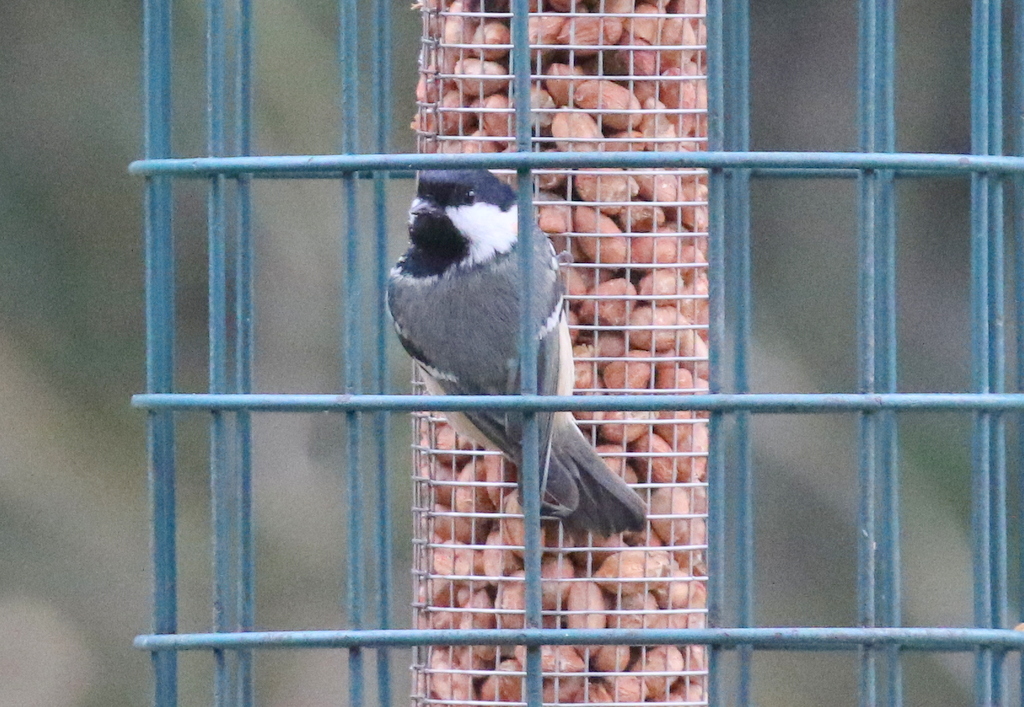
When we arrived in the car park at Strumpshaw, we could hear a Mistle Thrush singing. While we were eating lunch, a Great Spotted Woodpecker started drumming in the trees. It felt like spring might be on its way, despite the grey and gloomy weather! A flock of Siskin flew over calling and we heard a Redpoll overhead too.
After lunch, as we walked back to the car across the level crossing, we saw some movement in the ivy beside the track. We looked across and the head of a Redwing appeared. It was hidden at first, but it gradually clambered out to get a better angle to attack the berries. We could see the rusty orange (rather than ‘red’) patch on its flanks, under its wings.

The cloud had thickened noticeably while we were eating lunch, and it was already getting very dull, so we decided to head straight round to Hickling and out to the raptor roost watchpoint at Stubb Mill. As we made our way down the path, a couple of Marsh Harriers circled over the reeds.
When we arrived at the watchpoint, the resident pair of Cranes was already on view. It was not as good a view as the ones we had seen earlier, but we could see their heads and necks above the reeds. As well as raptors, this is a great place to see Cranes coming in to roost and as we stood and watched, more flew past. First three Cranes flew across in front of us, then another two came over the trees behind us, followed by 3 more in front. All dropped down towards the reserve and we could heard them bugling in the distance.

There was not a huge number of Marsh Harriers into the roost tonight. There were perhaps around ten or more scattered around in the bushes in the reeds when we arrived, including one carrying green wings tags but unfortunately it was too far away for us to reed the code. A trickle more flew in while we were standing at the watchpoint tonight.
A smart male Hen Harrier flew across, low over the fields in front of us, before heading off round behind the wood, possibly for some late hunting before going in to the roost. A while later, two male Hen Harriers could be seen with the Marsh Harriers, very distantly over the reeds by the ruined mill.
There were a few other things to see while we waited. A large flock of Pink-footed Geese flew up from the fields in the distance, over towards the road, and headed off to roost. A Tawny Owl hooted from the trees behind us. A couple of Chinese Water Deer appeared out on the grass. A Sparrowhawk flew across low over the grass and finally a Merlin appeared at the back, zipping across and up into a low bush on the edge of the reeds. The light was going fast now, so it was hard to see.
It was time to walk back. As we made our way along the road, we heard more bugling behind us, and looked back to see a large flock of 19 Cranes flying in over trees, closely followed by another 6. The Cranes dropped down towards the reserve, where we could hear them bugling. It was an impressive sight – and took our total count of Cranes for the evening to a massive 35!
There were no Barn Owls out hunting at Stubb Mill this evening, but once it was dark, on our way home, we came across two in the headlights – one which flew across in front of us and one perched on a post by the road.
















